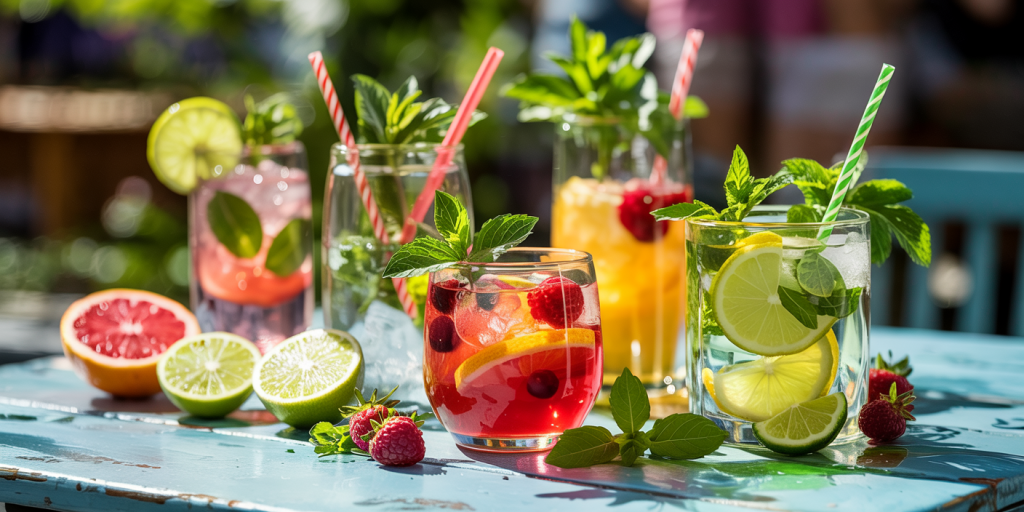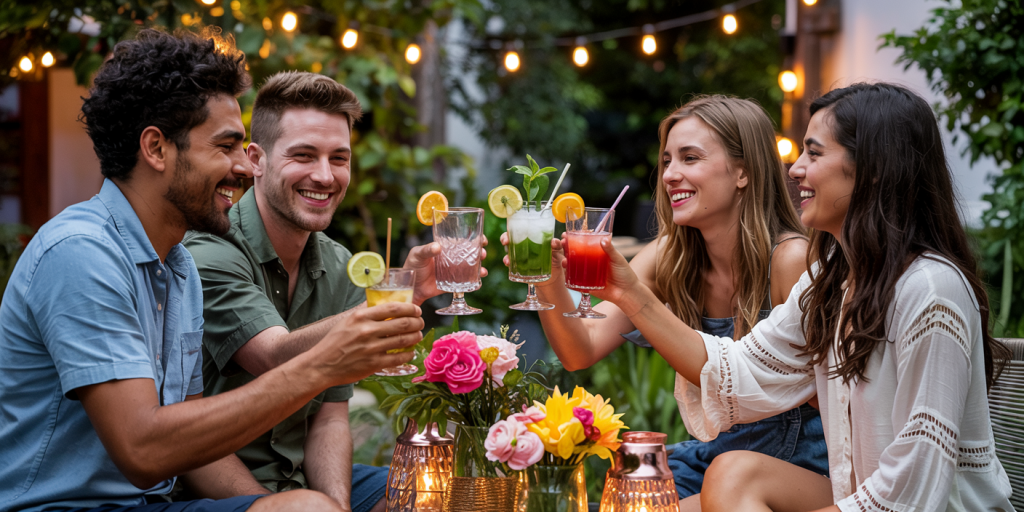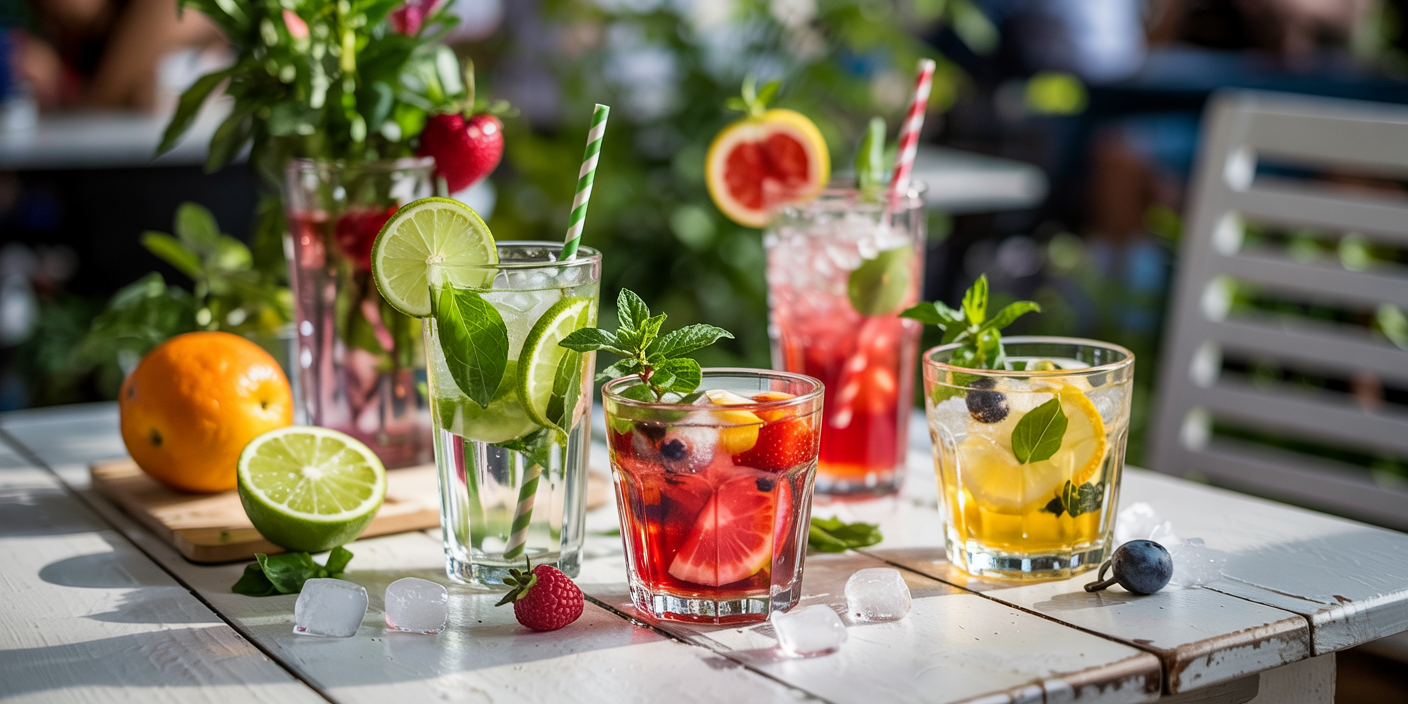As temperatures soar during the summer months, the quest for refreshing beverages grows ever more important. Summer mocktails—non-alcoholic, flavorful beverages—have carved out a niche in the world of drinks, offering a perfect blend of hydration, taste, and style without the buzz of alcohol. According to a 2023 Global Beverage Market report by Statista, the non-alcoholic drinks segment is expected to grow at a compound annual growth rate (CAGR) of approximately 7.4% through 2027, underscoring the surge in demand for healthier, flavorful drink alternatives.
Summer is not only synonymous with outdoor barbecues and pool parties but also with higher risks of dehydration and heat-related illnesses. Mocktails, enriched with fruits, herbs, and natural sweeteners, provide an ideal solution, combining the best of flavor and health benefits. This article explores the best refreshing summer mocktails, their ingredients, benefits, preparation tips, and emerging trends in the non-alcoholic beverage landscape.

—
The Science Behind Summer Hydration and Mocktails
Hydration during the summer is crucial. The American Journal of Clinical Nutrition highlights that adults lose between 1.5 and 2.5 liters of water daily through sweat during hot weather, and this loss can be exacerbated during physical activity. Mocktails thus serve a dual role: rehydrating the body while enhancing the flavor profile to encourage higher fluid intake.
Most commercial soft drinks contain high sugar content, which paradoxically can cause dehydration and energy crashes. Conversely, well-designed summer mocktails often incorporate ingredients rich in electrolytes—like coconut water and citrus fruits—that help restore the body’s mineral balance more effectively. For instance, a mocktail made with fresh lime juice, mint, and coconut water can replenish sodium, potassium, and magnesium, crucial for muscle function and fluid balance.

To illustrate, one practical example is the “Cucumber Cooler,” a mocktail combining cucumber juice, lime, and sparkling water. Cucumber is about 95% water and contains antioxidants such as cucurbitacins, making it both refreshing and beneficial for skin hydration during summer sun exposure. Its mildly sweet flavor bestows a cooling effect, ideal for combating heat stress.
—
Popular Summer Mocktail Recipes and Their Benefits
The appeal of summer mocktails lies in their variety and adaptability to different tastes and nutritional goals. Here are some popular recipes along with their health benefits:
1. Watermelon Mint Refresher Watermelon is over 90% water and rich in lycopene, an antioxidant linked to heart health and sun protection. This mocktail combines watermelon puree, fresh mint leaves, lemon juice, and a touch of honey or agave syrup. Mint stimulates digestion and provides a cooling sensation, enhancing gut comfort during summer meals.
2. Tropical Citrus Fizz A medley of pineapple juice, orange juice, and sparkling water, this drink mimics the colors of a tropical sunset. Pineapple contains bromelain, an enzyme known to reduce inflammation, while oranges provide vitamin C, bolstering immune function—a useful feature during peak summer allergy seasons.
3. Ginger Limeade Spritz Fresh ginger juice mixed with lime and club soda creates a zesty, refreshing drink. Ginger is well-documented for its anti-nausea and anti-inflammatory properties, making this mocktail an excellent option for those sensitive to heat or prone to digestive discomfort.
Each mocktail can be adapted by adjusting sweetness levels or carbonated water quantities to suit individual preferences. Not only do these mocktails serve as thirst quenchers, but they also contribute nutritional benefits, making them a win-win choice.
—
Comparing Mocktails and Traditional Summer Beverages: A Nutritional Perspective
Many consumers still default to sodas or sugary juices during summer, often unaware of the stark nutritional differences compared to mocktails crafted from fresh ingredients. Below is a comparative table of three common summer beverages per 12-ounce serving:
| Beverage | Calories | Sugar (g) | Electrolytes (mg) | Key Benefits | Potential Downsides |
|---|---|---|---|---|---|
| Cola Soda | 140 | 39 | Negligible | Caffeine boost | High sugar, dehydration risk |
| Commercial Fruit Juice | 160 | 35 | Low (except potassium) | Vitamin C | High sugar, low fiber |
| Fresh Watermelon Mint Mocktail | 70 | 12 | Potassium (200 mg), Magnesium (20 mg) | Hydrating, antioxidants, low sugar | Less caffeine (if desired) |
This comparison illustrates that mocktails can drastically reduce sugar intake while improving hydration and nutrient density. With childhood obesity rates climbing globally—WHO reports that over 340 million children and adolescents aged 5-19 were overweight or obese in 2016—switching to healthier beverages like mocktails could contribute to lowering added sugar consumption significantly.
—
Crafting the Perfect Mocktail: Tips and Techniques
Achieving the right balance of flavors in mocktails is an art that combines science and creativity. Several key techniques can elevate a simple drink to a signature summer refreshment: Fresh Ingredients Matter: Using fresh herbs (mint, basil), fruits (berries, citrus), and natural sweeteners (honey, agave) enhances aroma and complexity. For example, muddling mint leaves gently releases essential oils that heighten flavor without bitterness. Balancing Sweetness and Acidity: An ideal mocktail balances sugar and acidity to maintain refreshment without overwhelming the palate. Using natural acids like lime, lemon, or even tamarind can counterbalance sweetness and stimulate salivation, key to the sensation of refreshment. Texture and Temperature: Adding crushed ice or blending fruits adds textural depth and coolness. Using chilled glasses or serving cocktails with edible flowers can also heighten the sensory experience, crucial during hot months.
One practical case is the use of carbonated water versus still water in mocktails. Carbonation increases perceived refreshment by stimulating taste buds and can make drinks more complex without adding calories. However, some consumers with digestive sensitivity may prefer still mocktails to avoid bloating.
—
Summer Mocktails in Social and Cultural Contexts
Beyond health and hydration, mocktails have increasingly become a staple within social settings, including family gatherings, corporate events, and wellness retreats. This trend is fueled partly by growing awareness of alcohol-related harm and a shift toward mindful consumption, especially among millennials and Gen Z.
Research by NielsenIQ in 2022 showed a 25% increase in alcohol-free drink sales across premium liquor brands, indicating broad appeal for sophisticated, non-alcoholic beverages. Mocktails offer inclusivity by catering to non-drinkers and designated drivers while maintaining festive experiences. For instance, at summer weddings, offering a curated mocktail menu alongside wine and cocktails elevates guest satisfaction and ensures everyone can participate in celebratory toasts.
On a cultural level, many traditional summer beverages around the world function as de facto mocktails—Indian “nimbu pani” (lemonade with salt and spices), Mexican agua frescas (fruit-infused waters), and Middle Eastern rose or tamarind drinks prove the long-standing global appreciation for flavorful, non-alcoholic refreshers in hot climates.
—
The Future of Summer Mocktails: Trends and Innovations
Looking ahead, the future of summer mocktails seems bright and innovative, driven by consumer demand for healthier, environmentally friendly, and visually appealing beverages. Several emerging trends are shaping the landscape: Functional Ingredients: Adaptogens like ashwagandha, turmeric, and kombucha are increasingly incorporated into mocktails for added health benefits, from stress relief to immune support. Market reports by Grand View Research predict a significant CAGR of over 12% for functional beverages by 2028. Sustainability in Ingredients and Packaging: Consumers increasingly prefer locally sourced, organic fruits and recyclable packaging. Zero-waste cocktails, where peels and herbs are repurposed, are gaining traction in bars and home recipes alike. Technology and Home Mixology: Smart kitchen devices and apps now assist with fresh juice extraction, flavor pairing, and mocktail creation, making it easier than ever to experiment at home. Virtual mixology classes focusing on alcohol-free drinks have surged in popularity post-pandemic, reflecting broader wellness trends. Personalization and Customization: Consumer data analytics enable beverage brands to tailor mocktail recipes based on regional preferences, dietary restrictions (gluten-free, low FODMAP), and occasions, ensuring each individual’s ideal summer refreshment.
—
Crafting and enjoying refreshing summer mocktails offers a multifaceted approach to beating the heat—hydration, health benefits, and social connection. As the global beverage market continues evolving toward mindful drinking, these colorful, flavorful concoctions are set to become enduring favorites in summer kitchens and social gatherings worldwide.


Deixe um comentário